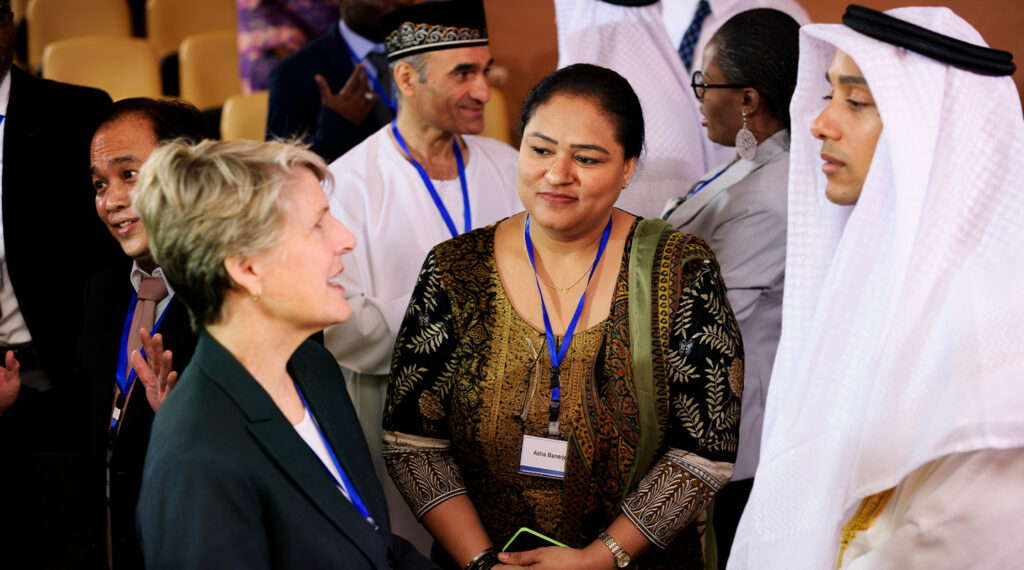UN Summit of the Future: Charting a new course for global collaboration

The atmosphere was electric at the United Nations headquarters during the 79th session of the UN General Assembly (UNGA 79) and the Summit of the Future. Urgency, hope, and a fair measure of scepticism mingled in the grand halls.
Action days: a prelude to the summit
Leading up to the Summit were the Action Days, which attracted over 7,000 attendees to a broad series of events. Having received special accreditation, I participated on behalf of CIFS in sessions addressing the shrinking civic space, chaired by the Danish Ministry of Foreign Affairs, demonstrating strong diplomatic support for the UNMUTE initiative that works for meaningful UN participation. Another session focused on systems thinking and long-term challenges, with Wales’s Office of the Commissioner for Future Generations standing out as a pioneering example.
A highlight was the launch of “Future Ours” by ART 2030, an exhibition bringing artists’ perspectives to the streets of New York, inviting us all to imagine what could be. This thought-provoking initiative beautifully reminds us that our future belongs to everyone, and that art plays a key role in fostering the social imagination needed to envision it. As global challenges grow more complex and the pace of change accelerates, approaches such as futures literacy and foresight were highlighted as crucial tools for modern, evidence-based, and anticipatory policymaking, collaboration and leadership.
The Russian effort to derail the pact and the African Group’s response
During the address of the Pact for the Future the Russian Federation attempted to introduce an amendment that could potentially derail the agreement.
In a strategic and decisive move, the African Group, chaired by Congo, proposed a no-action motion, intending to safeguard the integrity of the Pact and expedite its adoption, acknowledging the efforts that had gone into it and demonstrating strong support for the outcome document.
Following the successful no-action motion, the Pact for the Future was adopted without a vote. This procedural outcome underscored the collective commitment of the international community to the agreed-upon terms of the Pact and its annexes: the Global Digital Compact and the Declaration on Future Generations.
Key outcome documents: Significance, pitfalls, and challenges
Despite the Summit’s significant achievements, the process was not without flaws. Many participants and observers noted that negotiations were less inclusive than desired, with marginalised groups and civil society often feeling sidelined. There were calls for the Pact to adopt more progressive language and make bolder commitments, especially in areas like human rights, climate action, and digital governance. Critics argue that while the Pact is a step forward, it falls short of addressing systemic issues requiring transformative change. The cautious language and lack of binding commitments reflect compromises that, while necessary for consensus, may limit the Pact’s impact.
- Limited recognition of civil society diversity: The Pact acknowledges the importance of civic space and civil society’s role in peacebuilding but falls short of recognising the diverse components of civil society, such as activists and human rights defenders. Resistance from some nations during negotiations led to a more constrained acknowledgment.
- Insufficient focus on digital peace and security: The Global Digital Compact lacks a comprehensive vision for digital peace and security. The omission of commitments to affirm international law in the digital realm and protect critical infrastructure leaves a critical gap in addressing the complexities of the digital age.
- Implementation challenges: Without binding enforcement mechanisms, there is a risk that the commitments made may not translate into tangible action. Monitoring the commitments, especially from Global North countries, will be crucial to ensure the necessary financing for the 2030 Agenda and climate action.
From words to action
The adoption of the Summit’s outcomes by 143 nation-states, accompanied by lofty remarks in the General Assembly Hall, brings cautious optimism. Secretary-General António Guterres emphasised the need for a paradigm shift: “We can’t build a future for our grandchildren with a system built for our grandparents.” This sentiment resonates deeply, highlighting the imperative to prioritise future generations in our current decision-making processes.
The true measure of success lies in the commitment of Member States to implement these agreements. Countries like Denmark are poised to play a significant role. With its upcoming term on the Security Council (2025-2026), Denmark is well-positioned to influence negotiations on Council reform and support initiatives that strengthen human rights and civil society participation.
From niche practices to core components and the role of philanthropy
After years of witnessing the development of futures literacy and foresight from niche practices to being acknowledged as integral components of global governance, there is a renewed sense of hope and responsibility. The Summit of the Future is more than an event; it is a call to action for all of us to contribute to building a hopeful and sustainable future for generations to come.
The grandeur of the Summit is reflected not just in its scale but in its potential to catalyse meaningful change. The tensions and challenges faced underscore the complexities of global governance but also highlight the importance of perseverance and collaboration. As we move forward, the focus must shift from words to action. Implementing the commitments made requires collective effort, transparency, accountability, and local integration – all areas where philanthropic organisations can offer significant contributions.
As an example, the adoption of this new approach by global governance entities like the UN directly invites more extensive collaboration in addressing global challenges. This approach acknowledges that governments alone cannot tackle the complex issues facing our world today; instead, it requires the collective efforts of all sectors of society, including philanthropic institutions.
This is where the insights presented by Philea and the Copenhagen Institute for Futures Studies in “Futures Philanthropy: Anticipation for the Common Good” become vital. By integrating foresight and futures thinking into philanthropic practices, foundations can not only enhance their risk-taking and innovative capacities but also empower civil society and communities to anticipate and adapt to future uncertainties. Ultimately, the opportunity for philanthropy to embrace futures thinking has never been more critical, as it can catalyse meaningful change and contribute to a more resilient and sustainable future for all.
- Read analysis from Global Focus on the process and outcomes here, which has been paraphrased through this post,
- Read the adopted Pact for the Future and its annexes here.
- Read School of International Futures handbook for implementation of the Declaration on Future Generations here.
- Read the Wales Protocol for Future Generations here.
Authors

